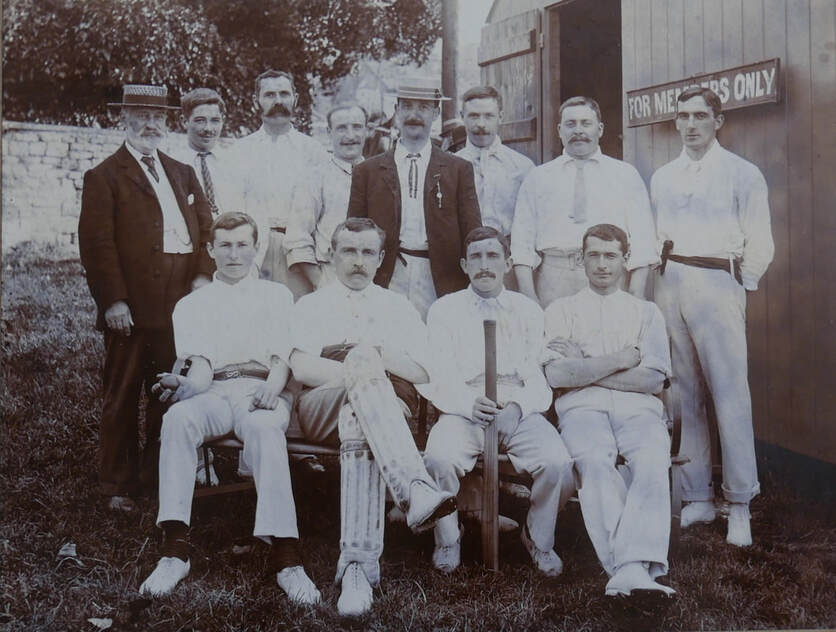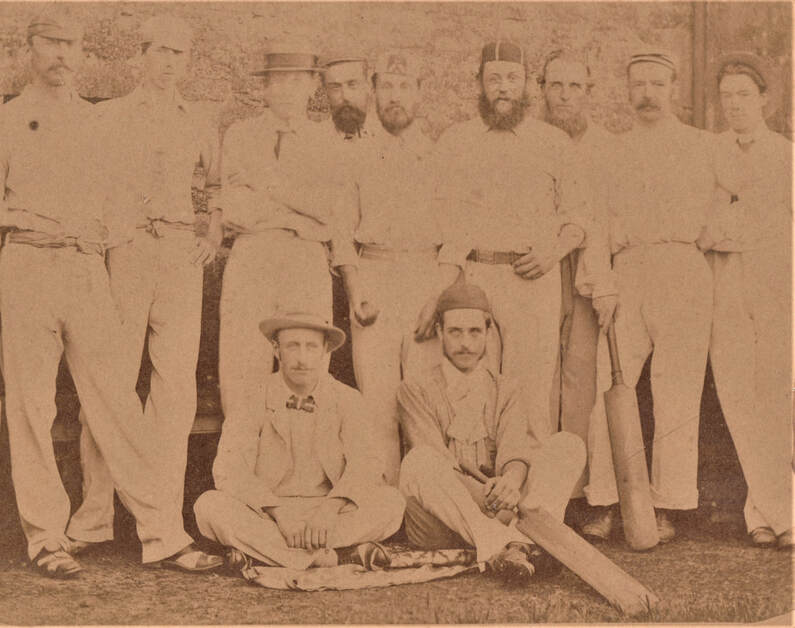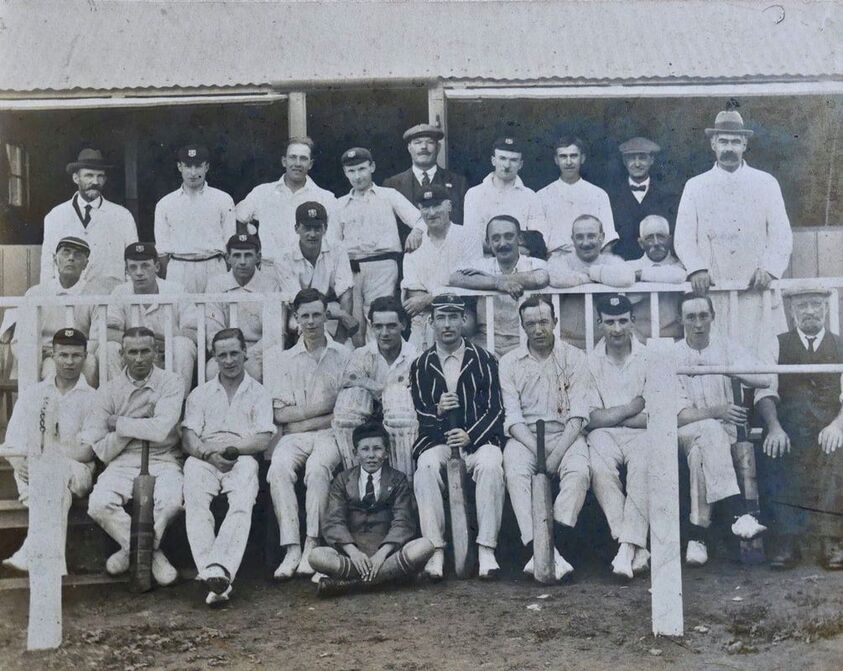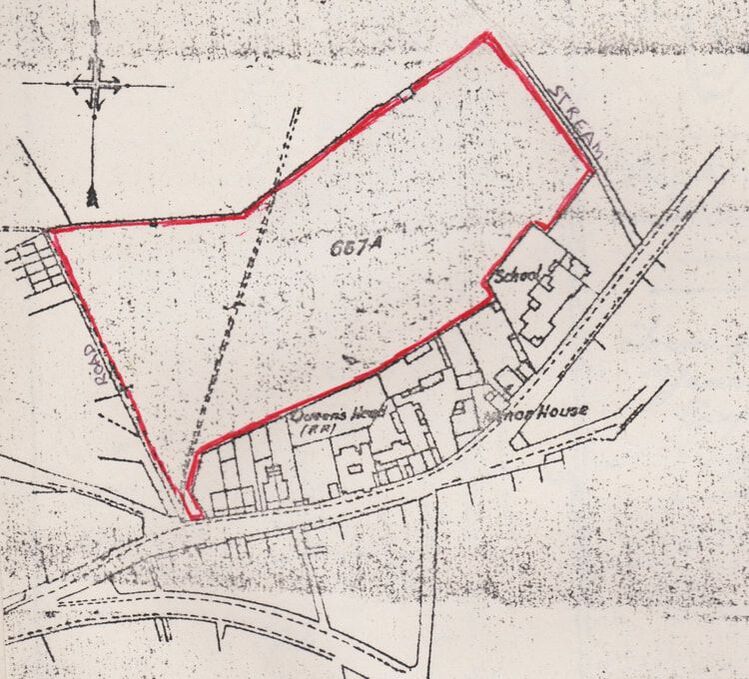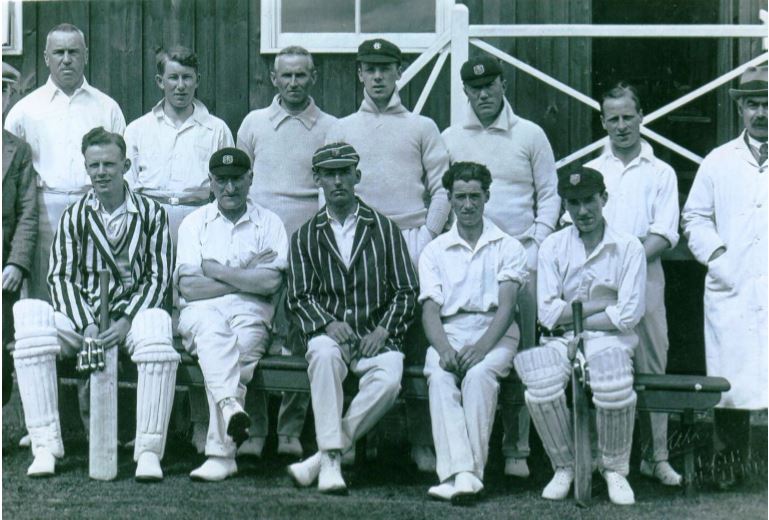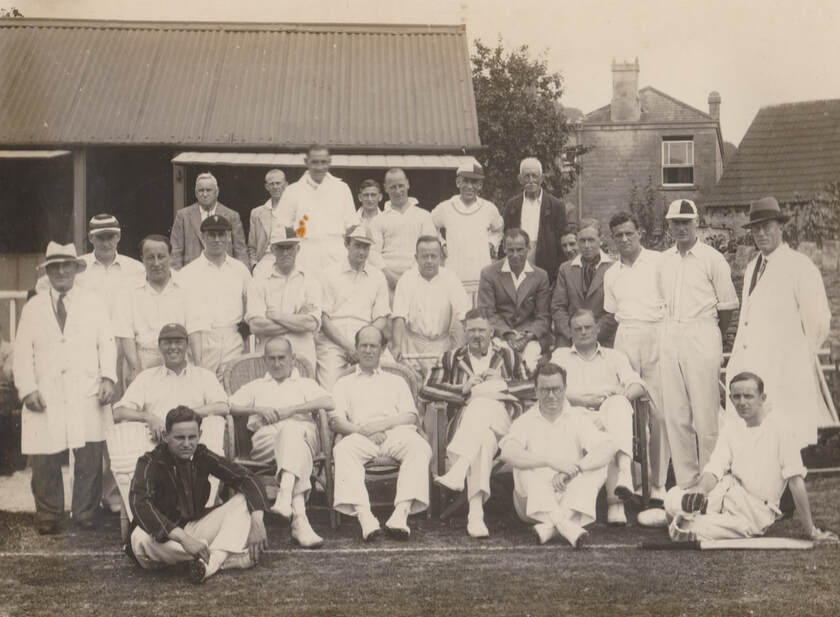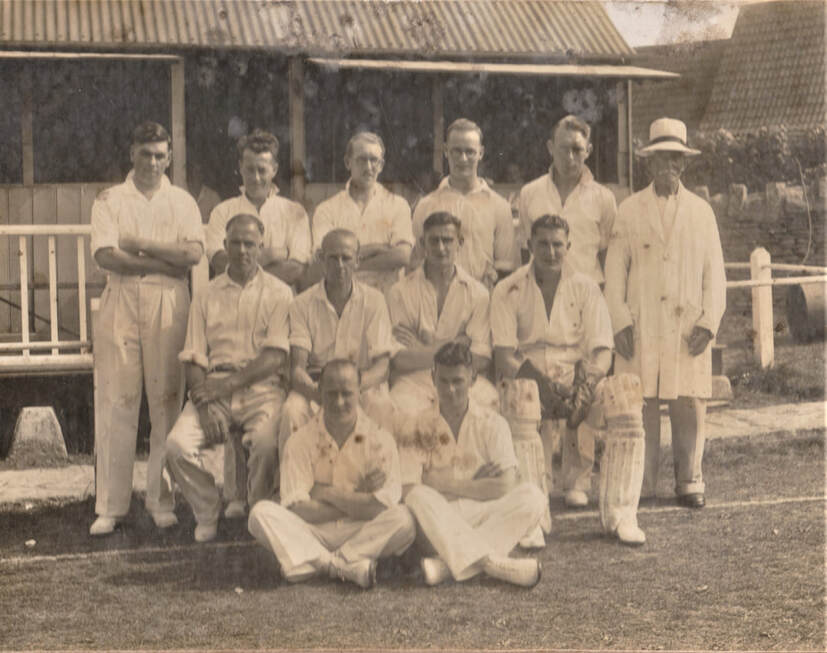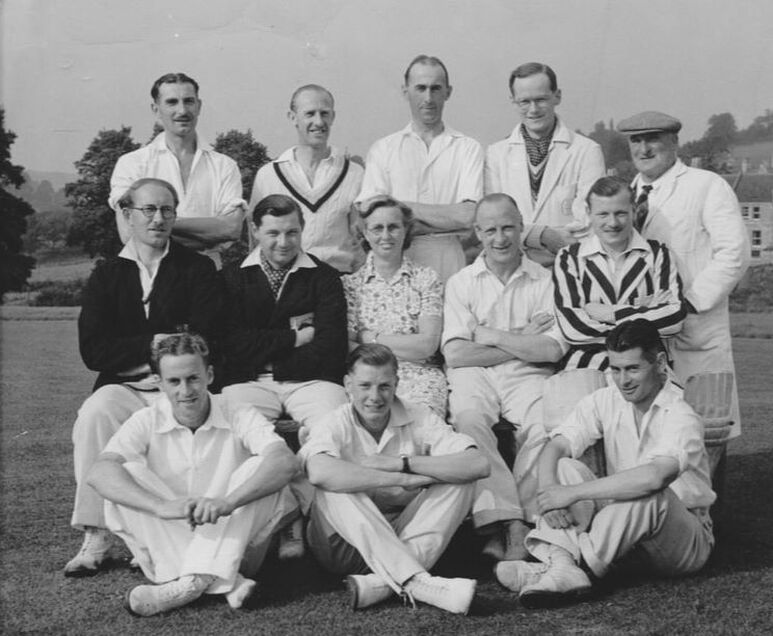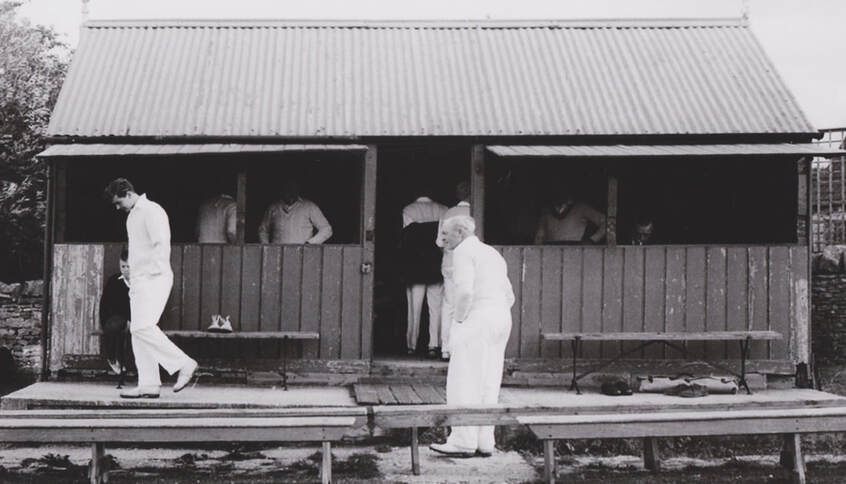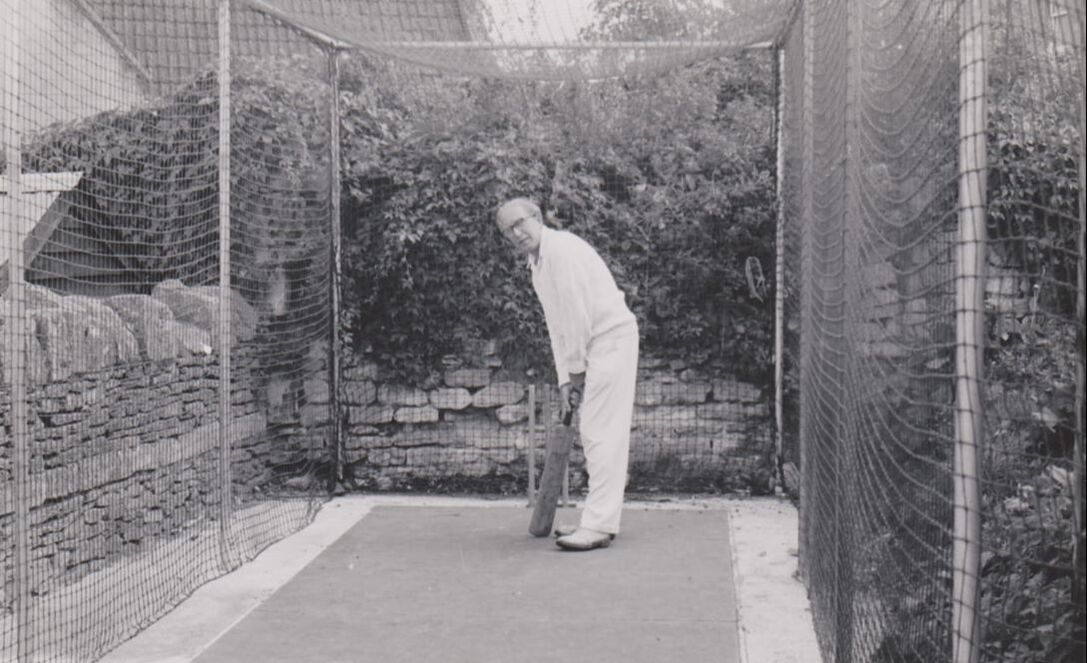Box Cricket Club Part 1: Early History 1870 - 1970 Text and photos Mike Warren April 2020
Having lived all my life in the parish of Box and being involved as an onlooker, player and officer at Box Cricket Club since the early 1950s, I thought I would try to record the 150th anniversary of the club. In no way can I compete with the language used by Don Bradfield in his book, A Century of Village Cricket. but I can record the story of the last 50 years not in Don's book. Unlike him, I have no family story about relatives who graced the fields of Mead Farm but I must have covered every blade of grass on that field where I spent over 40 years thoroughly enjoying the game of cricket and the company of great team mates.
Beginnings of Box Cricket Club
The earliest mention of the men of Box having a cricket team was in the 1850s.They were called the Box Mechanics and played their matches on what then was common ground behind Totney Corner, Kingsdown where golf is now played. There is mention in the minute book about the golf and cricket clubs sharing the cost of the leather shoes that covered the horses' hooves. These were to stop the hooves sinking into the ground as the horses pulled the roller to flatten the cricket wicket and the golf greens.
Later, on the 27 April 1870, at a meeting in an upper room of The Chequers public house in the Market Place, a group of men met to form the Box Cricket Club. It was decided that the newly-formed club would continue to play their matches at Kingsdown while practice sessions were to take place at Middle Hill.
The earliest mention of the men of Box having a cricket team was in the 1850s.They were called the Box Mechanics and played their matches on what then was common ground behind Totney Corner, Kingsdown where golf is now played. There is mention in the minute book about the golf and cricket clubs sharing the cost of the leather shoes that covered the horses' hooves. These were to stop the hooves sinking into the ground as the horses pulled the roller to flatten the cricket wicket and the golf greens.
Later, on the 27 April 1870, at a meeting in an upper room of The Chequers public house in the Market Place, a group of men met to form the Box Cricket Club. It was decided that the newly-formed club would continue to play their matches at Kingsdown while practice sessions were to take place at Middle Hill.
After a while, the long trek up the hill to Kingsdown proved to be unpopular, so, the field at Farm Mead was rented for the season in 1874. Now the club had their own field for practice and their Saturday matches. The steeply-sloping field was rough and uneven but the men managed to cut out and prepare a small wicket. Cows and sheep grazed on the rest of the rough field. A tent was erected for use as pavilion, changing room and tea room as well as for holding the Annual General Meeting.
The only buildings along the road were the village lock-up, the Queen’s Head and Manor Farm House. Box School, which in fact was three separate schools, a boys’, a girls’ and an infants’ was not built until 1875. The cricket team travelled to away matches in a horse-drawn brake, a cart with benches down each side. They would sing their way to and from the games, returning home with a few pints of cider inside them. The Bear pub was used for committee meetings and also for drinking after the home matches.
Early fixtures were held against Corsham, the Bath Association, Batheaston, Bathford, Melksham, Potterne and Lansdown. Later there were games against Marshfield, Freshford, Grosvenor, Kensington and Redland. The start of the 1891 season saw the introduction of a Saturday Second XI team and in 1897 a wooden hut, with the players’ entrance on the side, was constructed with a separate tea hut. These facilities were a great improvement for the club.
The only buildings along the road were the village lock-up, the Queen’s Head and Manor Farm House. Box School, which in fact was three separate schools, a boys’, a girls’ and an infants’ was not built until 1875. The cricket team travelled to away matches in a horse-drawn brake, a cart with benches down each side. They would sing their way to and from the games, returning home with a few pints of cider inside them. The Bear pub was used for committee meetings and also for drinking after the home matches.
Early fixtures were held against Corsham, the Bath Association, Batheaston, Bathford, Melksham, Potterne and Lansdown. Later there were games against Marshfield, Freshford, Grosvenor, Kensington and Redland. The start of the 1891 season saw the introduction of a Saturday Second XI team and in 1897 a wooden hut, with the players’ entrance on the side, was constructed with a separate tea hut. These facilities were a great improvement for the club.
Between 1900 and 1910, parts of Farm Mead outfield continued to be levelled with money being raised by holding concerts, jumble sales and annual dinners which were always well supported by the villagers. Soon afterwards there were dark clouds over Europe and the outbreak of war when men from the village were being asked to join up to fight. To save money, the lease on the Farm Mead field was given up between 1916 and 1919 with no games being played while the Great War took place. The club was restarted when hostilities ended and considerable improvements were made to the pavilion. The 1897 hut was transformed into a pleasing structure with a veranda and central doorway so that players no longer had to walk out to bat from a side door. Once again a further portion of the outfield was levelled. Travel by the brake came to an end with the arrival of Browning’s Boxonian motor coach. Of course, that did not end the singing of songs on the way to and from matches.
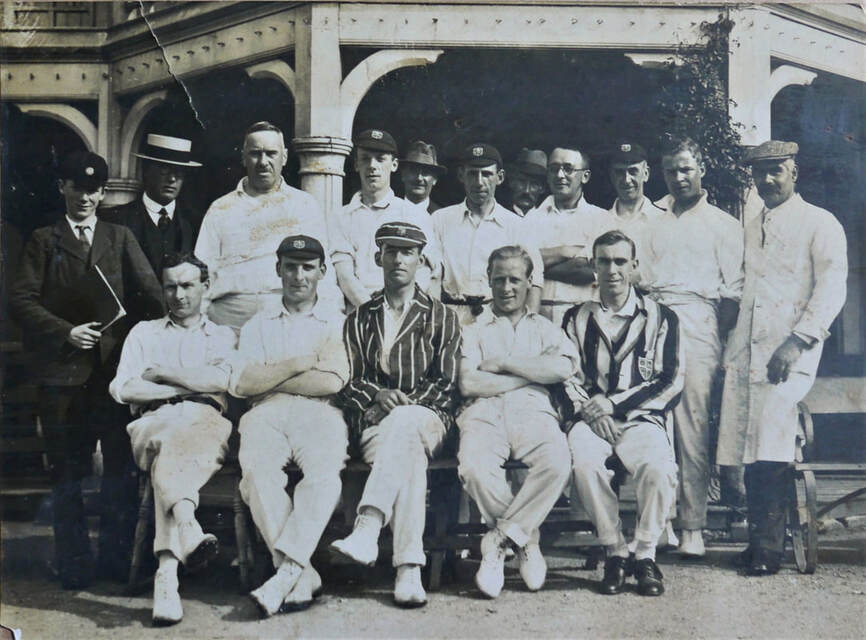
Team photo taken at Trowbridge's ground in 1925. Back Row: Jack Tottle (scorer), Stephen McIlwraith, W Martin, Jack Eyles, Ben Vezey, James Browning, Tom Lambert, JW Browning, E Vezey, J Shewring, A Nowell (umpire). Front Row: Cecil Lambert, W Benjamin, Jack Bradfield (captain), Alec Benjamin, S Burrow.
Permanent Home Established
In 1923 Sir Edward Northey put Farm Mead up for sale. It consisted of the Upper and Lower Fields, but Box Cricket Club quickly realised that they might lose out. Sir Edward drew up a deed of grant giving the club a 60-year lease on the land. It stated that Box Cricket Club had the right to play cricket on the top field until the lease ended in1983 and that no other games were to be played on that area. George Kidston, of Hazelbury Manor and a great supporter of the club, stepped in and bought the Upper and Lower Fields and in 1926, in a deed of gift, gave Farm Mead (now called The Rec) to the village.
In 1923 Sir Edward Northey put Farm Mead up for sale. It consisted of the Upper and Lower Fields, but Box Cricket Club quickly realised that they might lose out. Sir Edward drew up a deed of grant giving the club a 60-year lease on the land. It stated that Box Cricket Club had the right to play cricket on the top field until the lease ended in1983 and that no other games were to be played on that area. George Kidston, of Hazelbury Manor and a great supporter of the club, stepped in and bought the Upper and Lower Fields and in 1926, in a deed of gift, gave Farm Mead (now called The Rec) to the village.
There were conditions attached to the gift, which included:
- That the Cricket Club no longer needed to pay rent
- That the club could increase the playing area
- That at the end of the deed of gift, the parish council must offer the club a further deed of grant on terms no less favourable
- That only one building could be erected on the fields
- That an area of ground must be reserved as a playground for the school children of Box.
The club committee felt that all new members should be aware of these details so they ensured that extracts from the deed of grant were read out at every Annual General Meeting. These meetings were always held at the Schools. The Upper Field stretched from the allotments by the stream below Fairmead View down to the vicarage wall where the narrow road runs down to Valens Terrace. The parish council took over the responsibility of looking after the fields while the Cricket Club cared for the square area used as the wicket.
By 1928 the First team were playing 24 fixtures a season while the Second team had 18 fixtures. The outfield was cut by a horse which pulled a mower and Kingsdown Golf Club still shared the need for leather shoes over the hooves. There had always been a strong ladies' section who organised teas and fund-raisers with jumble sales and whist drives. In 1930 a ladies cricket section was formed to practise and play occasional matches. They were told that no high heeled shoes should be worn on the pitch.
By 1933 their few fixtures seem to have died out.
By 1928 the First team were playing 24 fixtures a season while the Second team had 18 fixtures. The outfield was cut by a horse which pulled a mower and Kingsdown Golf Club still shared the need for leather shoes over the hooves. There had always been a strong ladies' section who organised teas and fund-raisers with jumble sales and whist drives. In 1930 a ladies cricket section was formed to practise and play occasional matches. They were told that no high heeled shoes should be worn on the pitch.
By 1933 their few fixtures seem to have died out.
In 1932 a new landlord took over The Bear, so the Queen’s Head became the club’s headquarters, the reason given was that it was nearer to their pavilion at the rear of the Comrades Legion Club. For a while, prizes were given to players for the best batting and bowling averages but in 1936 it was decided to introduce honour boards instead.
In March 1940, during the Second World War, it was decided to cancel the Second XI fixtures because, one by one, the players were being called up to serve. Club fixtures were completely suspended during the years of 1942 to 1945, however, the RAF at Rudloe was granted part-time use of the ground.[2] Their matches were probably arranged by Rev Maltin who was seconded there as camp chaplain, as well as his duties as Box parish vicar. Some cricket was played on the Rec during the war years by the Pioneer Corps who were based at Ashley. The leading army light was Colonel Brocklebank, who being the commanding officer could bat and bowl as he pleased!
In April 1945 the committee met to hastily arrange a few fixtures and in the following year the Comrades Legion Club was used for players to enjoy a pint after the game. 1946 was also the year that the Wiltshire County Cricket Association was formed with Box one of the founding members.
In April 1945 the committee met to hastily arrange a few fixtures and in the following year the Comrades Legion Club was used for players to enjoy a pint after the game. 1946 was also the year that the Wiltshire County Cricket Association was formed with Box one of the founding members.
Normality returned in 1948, when the Second XI fixtures were restored, and Brownings again supplied transport to away games. A very large, permanent, metal scoreboard was gifted to the club and erected next to the pavilion at the rear of the Comrades Club. A Sunday away fixture was arranged for Box to play against Exmouth with travel by coach and this fixture continued for several years. Box parish council continued to refuse to allow any Sunday sport. Box Rovers Football Club requested that football could be played on the slope from the edge of the square down to the vicarage wall. There were no tennis courts, bowling green or Selwyn Hall at the time. Although the deed of gift said that football was not allowed on that portion of the field, the Rovers were given permission for their games between 1949 and 1955. During 1954 work began on levelling the bottom field which was finally finished the following year and the area between the two fields landscaped with trees planted on the edge of the Upper Field. The Box Rovers Saturday Football team now had a long walk to and from their pitch from the changing rooms above the village public conveniences, now the house called The Old Sweet Factory on the opposite side of the road to the Queen's Head public house. The cricket ground was then free of possible disruption to the pitch from football.
Renewing the Club's Rights
During these years, some residents of the village began to question the rights which the Cricket Club seemed to have acquired, sometimes unaware of the 1926 deed of gift. The council and the club wished to ensure that interests were settled for the future. A new 66-year lease was drawn up to be signed when the council realised that it gave the club rights not previously held. The parish council wanted to develop The Rec with other sporting facilities to make full use of it. The draft of a further deed was drawn up but the Cricket Club then realised that this restricted their rights. Discussions carried on for several years with this impasse and the parish council took the case for legal opinion.
In the end the two parties compromised and on 18 May 1954 they agreed the following resolutions:
During these years, some residents of the village began to question the rights which the Cricket Club seemed to have acquired, sometimes unaware of the 1926 deed of gift. The council and the club wished to ensure that interests were settled for the future. A new 66-year lease was drawn up to be signed when the council realised that it gave the club rights not previously held. The parish council wanted to develop The Rec with other sporting facilities to make full use of it. The draft of a further deed was drawn up but the Cricket Club then realised that this restricted their rights. Discussions carried on for several years with this impasse and the parish council took the case for legal opinion.
In the end the two parties compromised and on 18 May 1954 they agreed the following resolutions:
- That the club shall have access to the field at all times.
- The council could restrict vehicles from entering onto the field
- The club to remain responsible for the maintenance of the square but the council should maintain the rest of the field. There would be no objection if the club wished to mow the field to the boundary with their own mower
- The club wished to be consulted as to the use of the field outside the boundary.
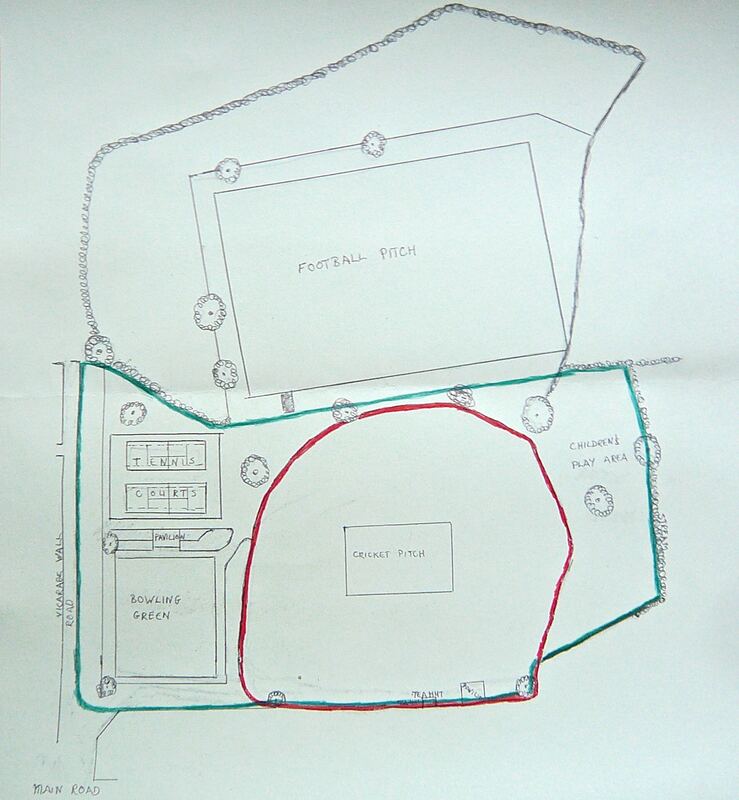
The 1954 lease from Box Parish Council showing the cricket playing area (red) and the proposed sports facilities under their statutory powers conferred by the Physical Training and Recreation Act, 1937. The whole area had originally been used as the cricket ground. This early plan has the bowling green and tennis courts reversed.
In the meantime, cricket continued to be enjoyed by two Saturday teams and the club took part in the first 1952 Wiltshire Cricket Association Knock-out Competition. New practice netting was purchased for the three evenings that practice happened. On each occasion, an area of ground near the pavilion boundary needed to be cut and rolled before practice took place. The Brownings 33-seater charabanc was still being used for away matches as not enough players owned cars to transport everyone. It is interesting to note that at the 1953 AGM. Mr PH Lambert suggested that we keep 1954 as our centenary as we had a newsprint copy of a match having been played in 1854 against Twerton. He thought that a Magazine be written up of the history of the Club. It was suggested that the team was, in fact, the Box Mechanics. The club again approached the parish council for permission to play Sunday cricket but, after referring the matter to a public meeting, the proposal was turned down.
Work continued to level the outfield, repair parts of the pavilion and lay on water into the visitor’s changing room with a wash basin erected. Up until that time only a bowl of water was provided. Toilet facilities were probably not available until later when the laying of a water pipe was discussed and in 1955 an Elsan toilet was fitted at the rear of the pavilion. In 1957 the council had plans drawn up with two tennis courts, a bowling green and a pavilion on the Rec. They were to be sited on the grounds parallel to the lane down to Valens Terrace but this was alongside the boundary of the outfield on the west side of the ground. Any ball hit for six would land on the bowling green or in the tennis courts, endangering persons using those facilities. Finally, in 1961, the parish council allowed the club to play Sunday fixtures on the ground at Box. Within a few years Sundays proved to be very popular with the club having a very strong fixture list.
Work continued to level the outfield, repair parts of the pavilion and lay on water into the visitor’s changing room with a wash basin erected. Up until that time only a bowl of water was provided. Toilet facilities were probably not available until later when the laying of a water pipe was discussed and in 1955 an Elsan toilet was fitted at the rear of the pavilion. In 1957 the council had plans drawn up with two tennis courts, a bowling green and a pavilion on the Rec. They were to be sited on the grounds parallel to the lane down to Valens Terrace but this was alongside the boundary of the outfield on the west side of the ground. Any ball hit for six would land on the bowling green or in the tennis courts, endangering persons using those facilities. Finally, in 1961, the parish council allowed the club to play Sunday fixtures on the ground at Box. Within a few years Sundays proved to be very popular with the club having a very strong fixture list.
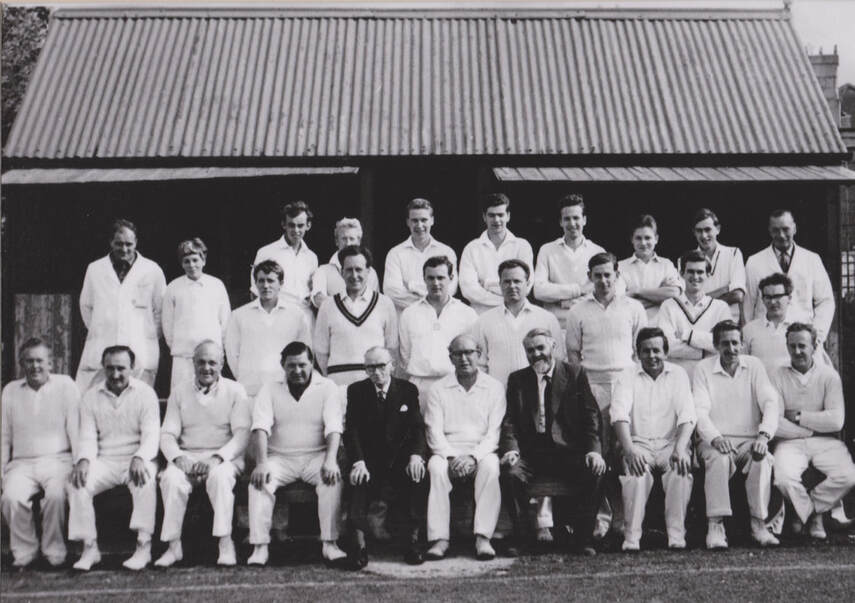
Box Cricket Club players in 1964 Just before the old pavilion was dismantled. Ted Simpkins (umpire), S Lambert, Anthony Smith, Steve Johns, Derek Baker, Alan Peacock, Robin Sawyer, Dave Boulton, George Greenman (umpire). Middle Row: Steve Lambert, John Harris, Roger Sumner, Brian Petty, Brian Sherriff, Clive Banks, P Fitzgerald. Front Row: Pete Milsom, Alf Turnbull, Pete Ody, Nigel Bence, Cecil Lambert, Phil Lambert, Don Bradfield, Joe Hope, Larry Chappell, D Wimble.
It is at this point that Don Bradfield’s book gives us no further information and the club’s minute books from early 1957 to 1970 are missing. So the following club matters are from memory alone. From the late 1950s the cricket club had held many fund-raising events to finance reserves for the building of a new pavilion. The club headquarters had moved from the Comrades Club to the Queen's Head where the batting side could sit on the wall at the rear of the car park with a great view to watch their side batting while enjoying a pint. It was decided that the best site for a pavilion would be in the garden of the Queen's Head, the garden being used at that time by John Miller of Miller's Coaches, who lived next door and grew his vegetables there. Courage Brewery were approached and after much discussion they granted permission to build a pavilion on a piece of land covering about a third of the garden area. A 60-year lease between the brewery and the club was signed on 25 March 1965 on these terms:
- A yearly rent of £15 and to pay any taxes or rates
- A requirement to keep it in good repair
- To erect and maintain a wood paling fence at the front of the property and a fence alongside the footpath between the car park and the recreation ground
- Not to alter the pavilion or erect any other building on the site
- To use the building solely as a cricket pavilion and not sublet
- Not to store, sell, distribute or drink alcohol on the premises.
The Old and New Pavilions
Our family had no television until the 1960s and, at the age of thirteen, I started wandering down to the Box Recreation ground on a Monday, Wednesday and Friday evening, as did many other youngsters. Those were the evenings when the club held its practice nights. I would stand in front of the pavilion and watch the players get ready and come out of the pavilion. The old cricket pavilion was on the edge of The Rec at the rear of the Comrades Legion Club (now converted into Hardy House). The pavilion was a wooden building with a corrugated iron roof. The large open front windows had shutters that hinged upwards towards the interior ceiling. The scorers sat at the desks looking through the windows where they could signal their acknowledgement to the umpires. The other three sides of the interior were covered with bench seats whose tops were hinged so that the club kit could be stored inside. In the middle of the last century nobody possessed their own kit of pads, bats, gloves and protectors so these were provided by the club in varying states of wear and quality. There were no helmets, arm or thigh guards for players. The steps and floorboards of the pavilion were rough and splintered from years of metal studs wearing away at them. You certainly did not want to wander around without shoes on. Next door to the pavilion was a small tea hut where sandwiches and tea that had been prepared by the players’ wives, were collected by the players who sat on the benches positioned around the exterior. On the school side of the pavilion was a tall sheet metal scoreboard. It was so high that the numbers had to be hooked in place using a pole. This could be quite dangerous as the metal numbers often fell out of the gadget used to hook them high on the scoreboard.
Our family had no television until the 1960s and, at the age of thirteen, I started wandering down to the Box Recreation ground on a Monday, Wednesday and Friday evening, as did many other youngsters. Those were the evenings when the club held its practice nights. I would stand in front of the pavilion and watch the players get ready and come out of the pavilion. The old cricket pavilion was on the edge of The Rec at the rear of the Comrades Legion Club (now converted into Hardy House). The pavilion was a wooden building with a corrugated iron roof. The large open front windows had shutters that hinged upwards towards the interior ceiling. The scorers sat at the desks looking through the windows where they could signal their acknowledgement to the umpires. The other three sides of the interior were covered with bench seats whose tops were hinged so that the club kit could be stored inside. In the middle of the last century nobody possessed their own kit of pads, bats, gloves and protectors so these were provided by the club in varying states of wear and quality. There were no helmets, arm or thigh guards for players. The steps and floorboards of the pavilion were rough and splintered from years of metal studs wearing away at them. You certainly did not want to wander around without shoes on. Next door to the pavilion was a small tea hut where sandwiches and tea that had been prepared by the players’ wives, were collected by the players who sat on the benches positioned around the exterior. On the school side of the pavilion was a tall sheet metal scoreboard. It was so high that the numbers had to be hooked in place using a pole. This could be quite dangerous as the metal numbers often fell out of the gadget used to hook them high on the scoreboard.
|
The new pavilion was built during 1965. The site gave the players and spectators a great view of the wicket and practically the whole of the outfield, as had the old pavilion. The old pavilion and the old giant scoreboard were demolished.
A concrete practice wicket was laid close to the school playground wall with permanent netting. No longer did the players have to cut, roll and put up netting for a wicket every time they wished to practise. The parish council erected a large shed near the spot of the old pavilion which was then used to store a tractor, mowing machines and other equipment. |
Now that the cricket pavilion had been moved off the Farm Mead Field, there was no permanent building on the area.
The council realised that they were able to go ahead with building a centralised property on the Rec which would cater for a variety of sports. Plans were approved for the building of two tennis courts and a bowling green to be sited very close to the cricket boundary nearest the vicarage. These were constructed between 1965 and 1967, with a wooden shed between them for use as a temporary pavilion until a centralised complex could be built. A great asset to the community but the facility was dangerously close to the cricket area and where cricket balls were often struck. In 1967 a village hall was completed, which
Rev Tom Selwyn-Smith allowed to be built on his land, which is now called the Selwyn Hall and a large car park was laid with tarmac on the edge of the football field.
Memories of Players in 1960s
One early memory I have was of Curly Walker, a Box Hill man. I believe that Curly was a bachelor and would always be in the Lamb Inn before a game, having a thick beef sandwich and a few pints of the rough cider that he enjoyed. When the match started Curly would open the bowling. I often fielded at mid off and as Curly ran up to bowl, the players could hear the slosh, slosh, slosh of the liquid in his stomach. Sadly Curly died in 1963, a fairly young man. Even so, he still topped the bowling averages at the end of that season.
In the early 1960s we seemed to play often in the Bristol area. Some players would stay in the city to have a meal, making their own way home. As a youngster still at school, I had no money so I always caught the coach home. After one game I was invited by Alan Peacock, Clive Banks and David (Spud) Baker to join them for a meal to which they would treat me and we went for a steak meal in the centre of Bristol. The arrangement they had between themselves was to spoof (a game of tricking others) for the cost of the meal. By that time we had missed the coach return to Box so they agreed to spoof again for the taxi back. One member of the gang lost the spoof for the meal and lost again for the cost of the taxi home. The rules of the game were that, if you lost a second round in a row, it did not count because two consecutive losses meant you had a next round free. On the third round the same person lost again which meant that he had to pay for the meal for four plus the taxi back home from Bristol to Box, something that was never forgotten in the club's history.
The council realised that they were able to go ahead with building a centralised property on the Rec which would cater for a variety of sports. Plans were approved for the building of two tennis courts and a bowling green to be sited very close to the cricket boundary nearest the vicarage. These were constructed between 1965 and 1967, with a wooden shed between them for use as a temporary pavilion until a centralised complex could be built. A great asset to the community but the facility was dangerously close to the cricket area and where cricket balls were often struck. In 1967 a village hall was completed, which
Rev Tom Selwyn-Smith allowed to be built on his land, which is now called the Selwyn Hall and a large car park was laid with tarmac on the edge of the football field.
Memories of Players in 1960s
One early memory I have was of Curly Walker, a Box Hill man. I believe that Curly was a bachelor and would always be in the Lamb Inn before a game, having a thick beef sandwich and a few pints of the rough cider that he enjoyed. When the match started Curly would open the bowling. I often fielded at mid off and as Curly ran up to bowl, the players could hear the slosh, slosh, slosh of the liquid in his stomach. Sadly Curly died in 1963, a fairly young man. Even so, he still topped the bowling averages at the end of that season.
In the early 1960s we seemed to play often in the Bristol area. Some players would stay in the city to have a meal, making their own way home. As a youngster still at school, I had no money so I always caught the coach home. After one game I was invited by Alan Peacock, Clive Banks and David (Spud) Baker to join them for a meal to which they would treat me and we went for a steak meal in the centre of Bristol. The arrangement they had between themselves was to spoof (a game of tricking others) for the cost of the meal. By that time we had missed the coach return to Box so they agreed to spoof again for the taxi back. One member of the gang lost the spoof for the meal and lost again for the cost of the taxi home. The rules of the game were that, if you lost a second round in a row, it did not count because two consecutive losses meant you had a next round free. On the third round the same person lost again which meant that he had to pay for the meal for four plus the taxi back home from Bristol to Box, something that was never forgotten in the club's history.
This is Part 1 of a two part series on the history of Box Cricket Club. Mike brings the story up to date in the next issue of the website with players and events from 1970 until 2020, the 150th anniversary of Box's oldest club.
References
[1] Deed of Grant, 1923
[2] Courtesy Bill Cooper
[1] Deed of Grant, 1923
[2] Courtesy Bill Cooper
